Business Process Management Analysis: Joondalup Hospital Case Study
VerifiedAdded on 2022/09/15
|7
|1121
|28
Report
AI Summary
This report analyzes the business process management (BPM) of Joondalup Hospital, focusing on trends, process analysis, design, and development. It begins with an overview of BPM trends, emphasizing the importance of process analysis for identifying and improving inefficiencies within the hospital. The report examines the current patient registration and appointment scheduling processes, highlighting issues such as long wait times and potential data errors. Using BPMN diagrams, the report visualizes the 'As-Is' model of the hospital's processes, illustrating the steps involved in patient registration and appointment scheduling. The analysis is supported by references to academic journal papers, providing a foundation for understanding the complexities and potential improvements in the hospital's operational workflows. The report aims to provide insights for the management and staff of the hospital, without making any recommendations to fix the problems.
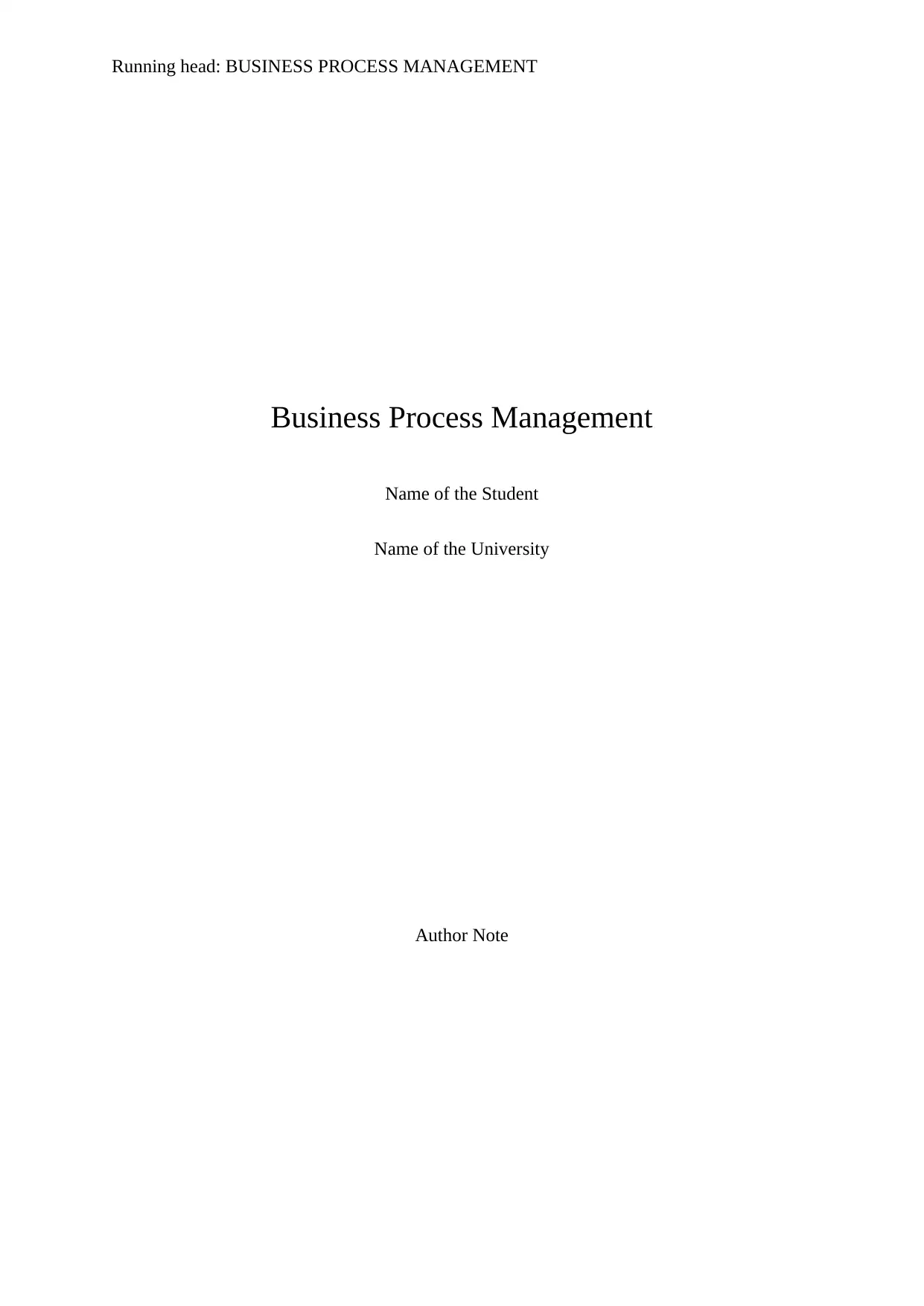
Running head: BUSINESS PROCESS MANAGEMENT
Business Process Management
Name of the Student
Name of the University
Author Note
Business Process Management
Name of the Student
Name of the University
Author Note
Paraphrase This Document
Need a fresh take? Get an instant paraphrase of this document with our AI Paraphraser
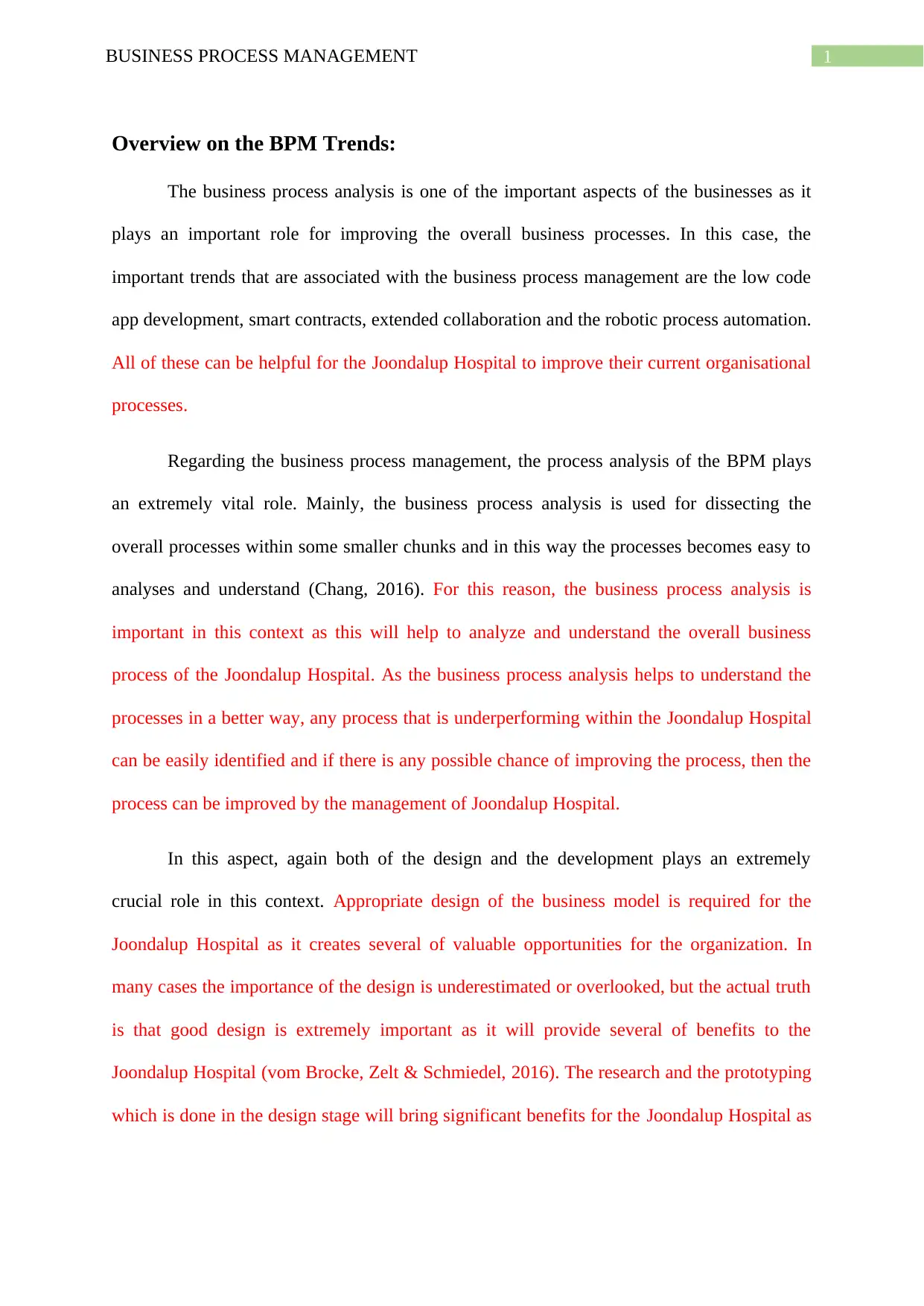
1BUSINESS PROCESS MANAGEMENT
Overview on the BPM Trends:
The business process analysis is one of the important aspects of the businesses as it
plays an important role for improving the overall business processes. In this case, the
important trends that are associated with the business process management are the low code
app development, smart contracts, extended collaboration and the robotic process automation.
All of these can be helpful for the Joondalup Hospital to improve their current organisational
processes.
Regarding the business process management, the process analysis of the BPM plays
an extremely vital role. Mainly, the business process analysis is used for dissecting the
overall processes within some smaller chunks and in this way the processes becomes easy to
analyses and understand (Chang, 2016). For this reason, the business process analysis is
important in this context as this will help to analyze and understand the overall business
process of the Joondalup Hospital. As the business process analysis helps to understand the
processes in a better way, any process that is underperforming within the Joondalup Hospital
can be easily identified and if there is any possible chance of improving the process, then the
process can be improved by the management of Joondalup Hospital.
In this aspect, again both of the design and the development plays an extremely
crucial role in this context. Appropriate design of the business model is required for the
Joondalup Hospital as it creates several of valuable opportunities for the organization. In
many cases the importance of the design is underestimated or overlooked, but the actual truth
is that good design is extremely important as it will provide several of benefits to the
Joondalup Hospital (vom Brocke, Zelt & Schmiedel, 2016). The research and the prototyping
which is done in the design stage will bring significant benefits for the Joondalup Hospital as
Overview on the BPM Trends:
The business process analysis is one of the important aspects of the businesses as it
plays an important role for improving the overall business processes. In this case, the
important trends that are associated with the business process management are the low code
app development, smart contracts, extended collaboration and the robotic process automation.
All of these can be helpful for the Joondalup Hospital to improve their current organisational
processes.
Regarding the business process management, the process analysis of the BPM plays
an extremely vital role. Mainly, the business process analysis is used for dissecting the
overall processes within some smaller chunks and in this way the processes becomes easy to
analyses and understand (Chang, 2016). For this reason, the business process analysis is
important in this context as this will help to analyze and understand the overall business
process of the Joondalup Hospital. As the business process analysis helps to understand the
processes in a better way, any process that is underperforming within the Joondalup Hospital
can be easily identified and if there is any possible chance of improving the process, then the
process can be improved by the management of Joondalup Hospital.
In this aspect, again both of the design and the development plays an extremely
crucial role in this context. Appropriate design of the business model is required for the
Joondalup Hospital as it creates several of valuable opportunities for the organization. In
many cases the importance of the design is underestimated or overlooked, but the actual truth
is that good design is extremely important as it will provide several of benefits to the
Joondalup Hospital (vom Brocke, Zelt & Schmiedel, 2016). The research and the prototyping
which is done in the design stage will bring significant benefits for the Joondalup Hospital as
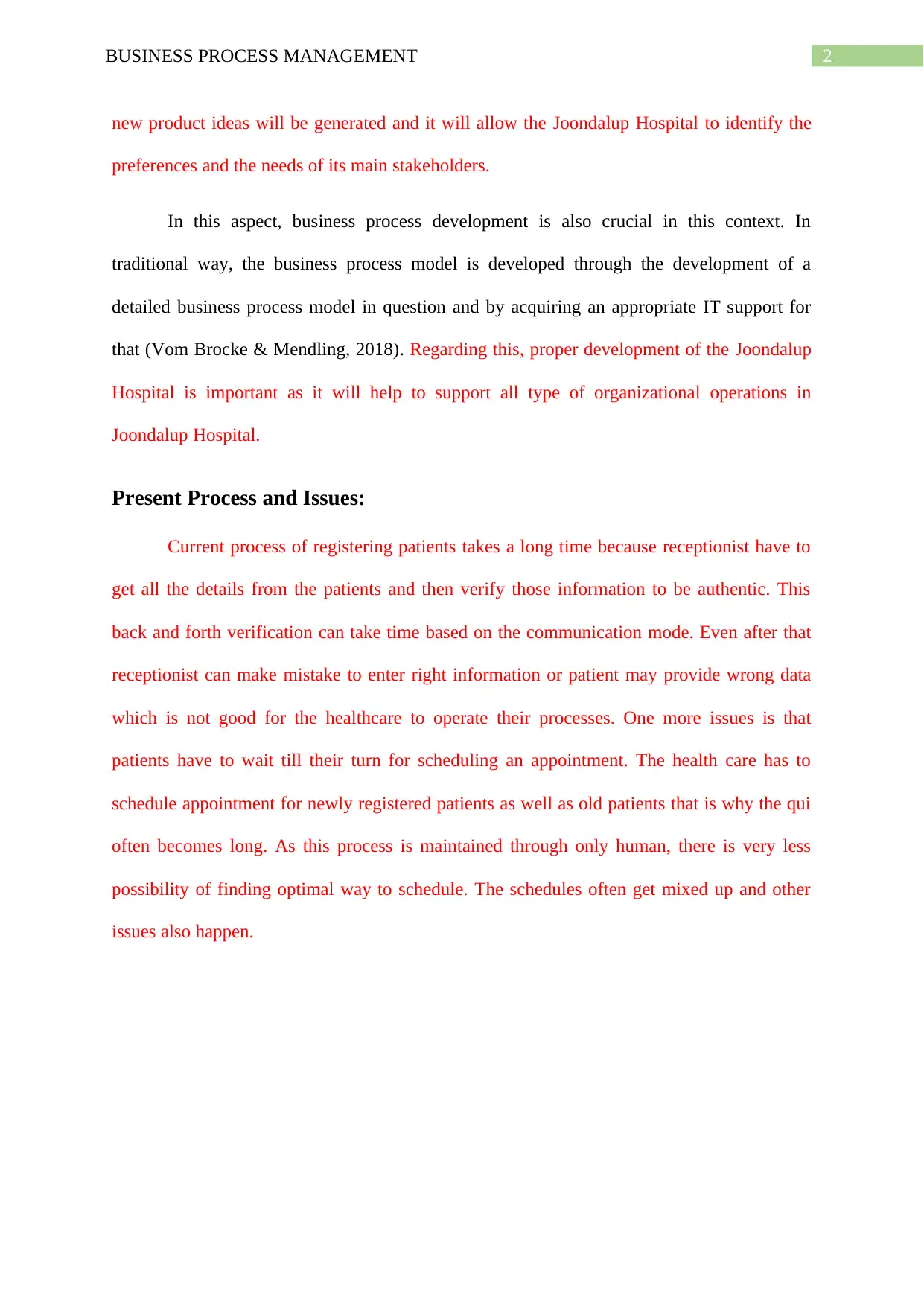
2BUSINESS PROCESS MANAGEMENT
new product ideas will be generated and it will allow the Joondalup Hospital to identify the
preferences and the needs of its main stakeholders.
In this aspect, business process development is also crucial in this context. In
traditional way, the business process model is developed through the development of a
detailed business process model in question and by acquiring an appropriate IT support for
that (Vom Brocke & Mendling, 2018). Regarding this, proper development of the Joondalup
Hospital is important as it will help to support all type of organizational operations in
Joondalup Hospital.
Present Process and Issues:
Current process of registering patients takes a long time because receptionist have to
get all the details from the patients and then verify those information to be authentic. This
back and forth verification can take time based on the communication mode. Even after that
receptionist can make mistake to enter right information or patient may provide wrong data
which is not good for the healthcare to operate their processes. One more issues is that
patients have to wait till their turn for scheduling an appointment. The health care has to
schedule appointment for newly registered patients as well as old patients that is why the qui
often becomes long. As this process is maintained through only human, there is very less
possibility of finding optimal way to schedule. The schedules often get mixed up and other
issues also happen.
new product ideas will be generated and it will allow the Joondalup Hospital to identify the
preferences and the needs of its main stakeholders.
In this aspect, business process development is also crucial in this context. In
traditional way, the business process model is developed through the development of a
detailed business process model in question and by acquiring an appropriate IT support for
that (Vom Brocke & Mendling, 2018). Regarding this, proper development of the Joondalup
Hospital is important as it will help to support all type of organizational operations in
Joondalup Hospital.
Present Process and Issues:
Current process of registering patients takes a long time because receptionist have to
get all the details from the patients and then verify those information to be authentic. This
back and forth verification can take time based on the communication mode. Even after that
receptionist can make mistake to enter right information or patient may provide wrong data
which is not good for the healthcare to operate their processes. One more issues is that
patients have to wait till their turn for scheduling an appointment. The health care has to
schedule appointment for newly registered patients as well as old patients that is why the qui
often becomes long. As this process is maintained through only human, there is very less
possibility of finding optimal way to schedule. The schedules often get mixed up and other
issues also happen.
⊘ This is a preview!⊘
Do you want full access?
Subscribe today to unlock all pages.

Trusted by 1+ million students worldwide
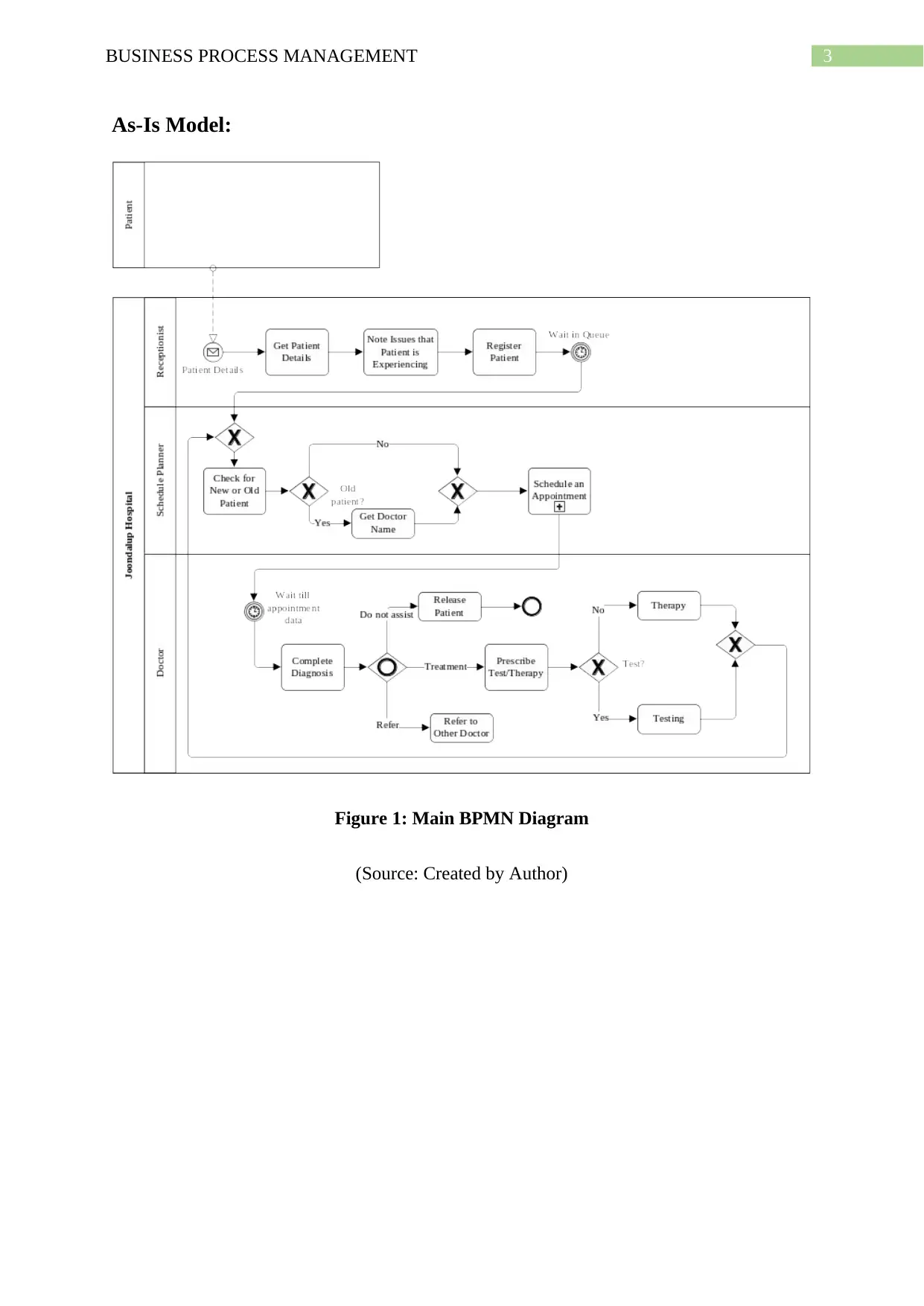
3BUSINESS PROCESS MANAGEMENT
As-Is Model:
Figure 1: Main BPMN Diagram
(Source: Created by Author)
As-Is Model:
Figure 1: Main BPMN Diagram
(Source: Created by Author)
Paraphrase This Document
Need a fresh take? Get an instant paraphrase of this document with our AI Paraphraser
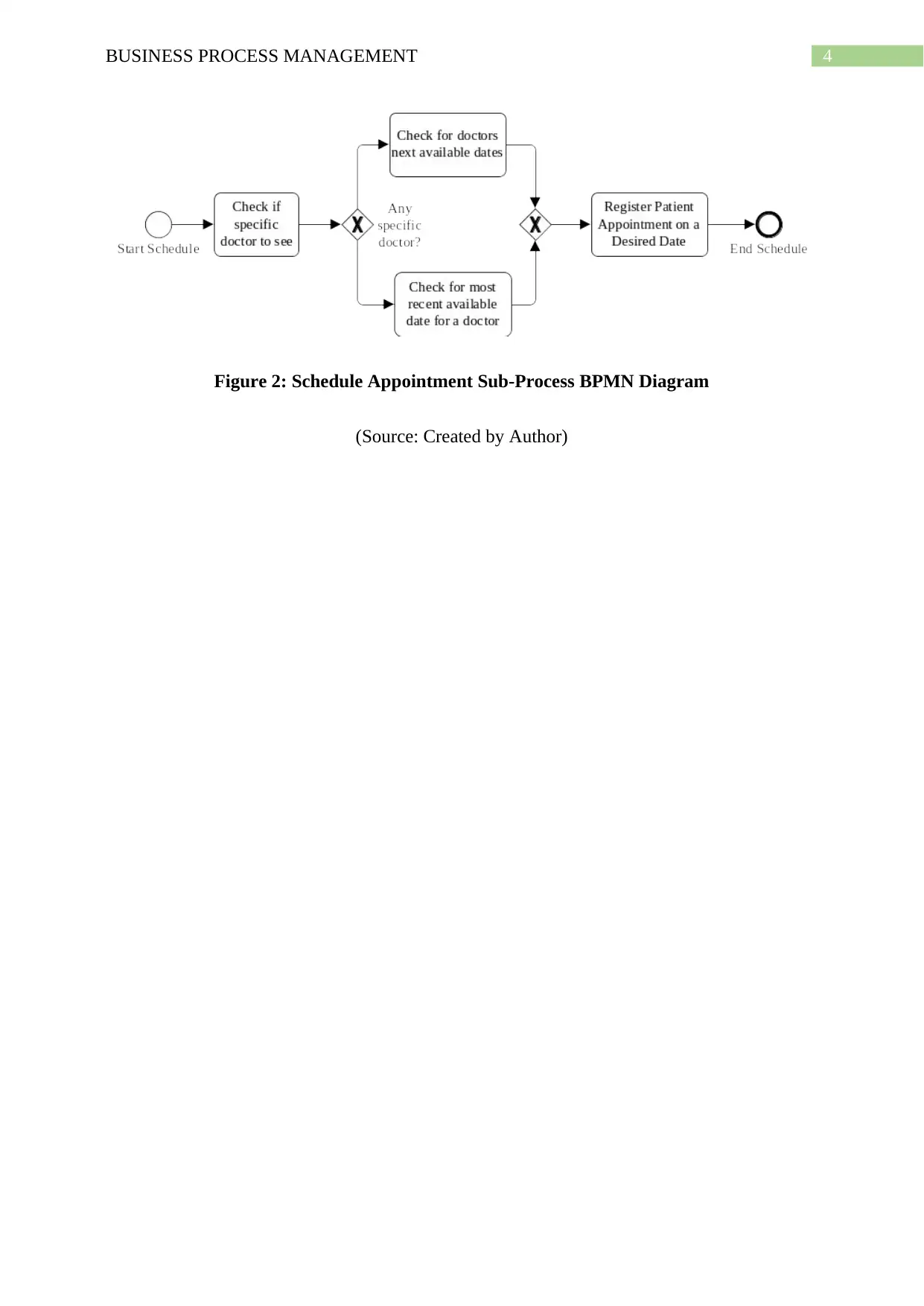
4BUSINESS PROCESS MANAGEMENT
Figure 2: Schedule Appointment Sub-Process BPMN Diagram
(Source: Created by Author)
Figure 2: Schedule Appointment Sub-Process BPMN Diagram
(Source: Created by Author)
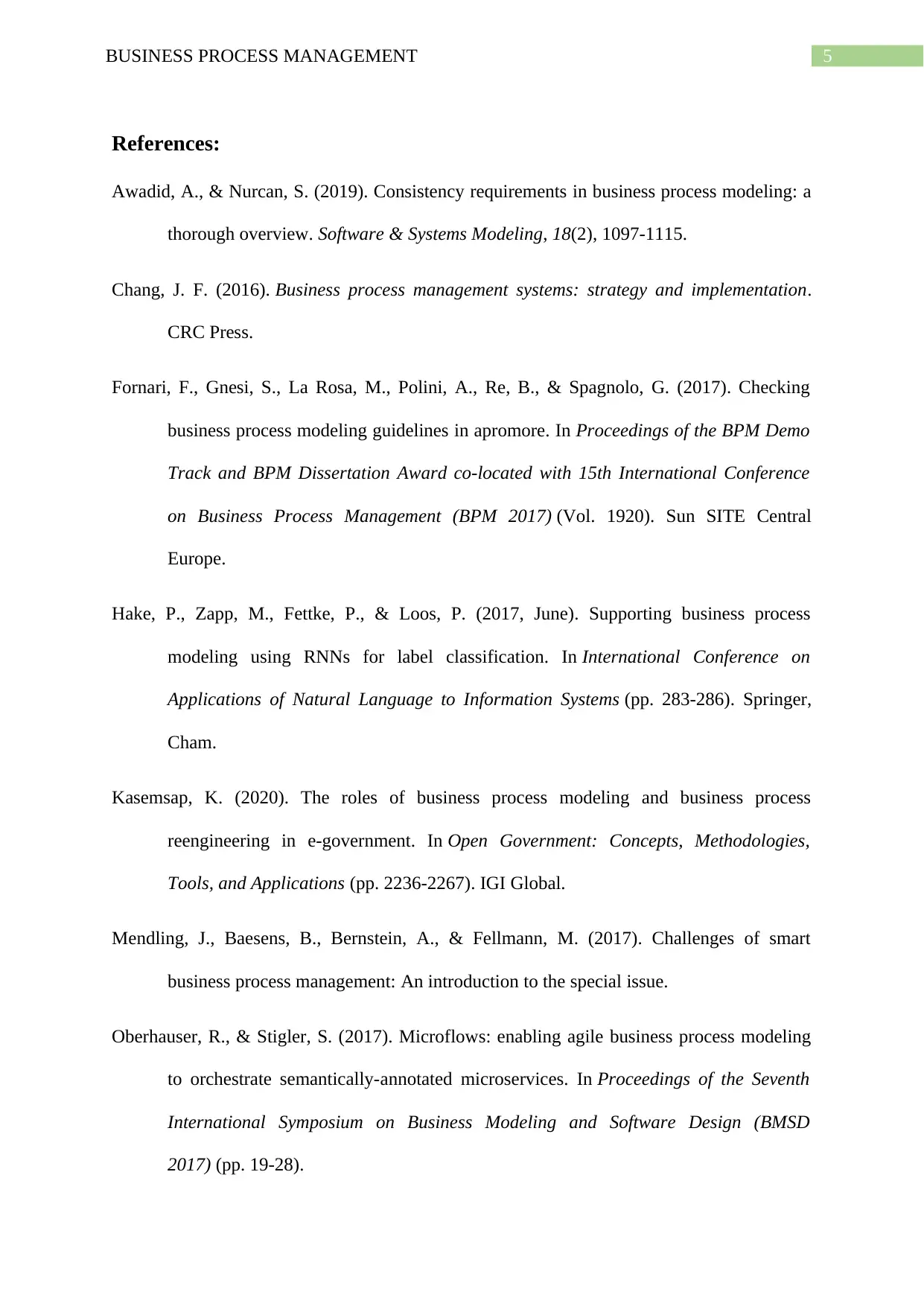
5BUSINESS PROCESS MANAGEMENT
References:
Awadid, A., & Nurcan, S. (2019). Consistency requirements in business process modeling: a
thorough overview. Software & Systems Modeling, 18(2), 1097-1115.
Chang, J. F. (2016). Business process management systems: strategy and implementation.
CRC Press.
Fornari, F., Gnesi, S., La Rosa, M., Polini, A., Re, B., & Spagnolo, G. (2017). Checking
business process modeling guidelines in apromore. In Proceedings of the BPM Demo
Track and BPM Dissertation Award co-located with 15th International Conference
on Business Process Management (BPM 2017) (Vol. 1920). Sun SITE Central
Europe.
Hake, P., Zapp, M., Fettke, P., & Loos, P. (2017, June). Supporting business process
modeling using RNNs for label classification. In International Conference on
Applications of Natural Language to Information Systems (pp. 283-286). Springer,
Cham.
Kasemsap, K. (2020). The roles of business process modeling and business process
reengineering in e-government. In Open Government: Concepts, Methodologies,
Tools, and Applications (pp. 2236-2267). IGI Global.
Mendling, J., Baesens, B., Bernstein, A., & Fellmann, M. (2017). Challenges of smart
business process management: An introduction to the special issue.
Oberhauser, R., & Stigler, S. (2017). Microflows: enabling agile business process modeling
to orchestrate semantically-annotated microservices. In Proceedings of the Seventh
International Symposium on Business Modeling and Software Design (BMSD
2017) (pp. 19-28).
References:
Awadid, A., & Nurcan, S. (2019). Consistency requirements in business process modeling: a
thorough overview. Software & Systems Modeling, 18(2), 1097-1115.
Chang, J. F. (2016). Business process management systems: strategy and implementation.
CRC Press.
Fornari, F., Gnesi, S., La Rosa, M., Polini, A., Re, B., & Spagnolo, G. (2017). Checking
business process modeling guidelines in apromore. In Proceedings of the BPM Demo
Track and BPM Dissertation Award co-located with 15th International Conference
on Business Process Management (BPM 2017) (Vol. 1920). Sun SITE Central
Europe.
Hake, P., Zapp, M., Fettke, P., & Loos, P. (2017, June). Supporting business process
modeling using RNNs for label classification. In International Conference on
Applications of Natural Language to Information Systems (pp. 283-286). Springer,
Cham.
Kasemsap, K. (2020). The roles of business process modeling and business process
reengineering in e-government. In Open Government: Concepts, Methodologies,
Tools, and Applications (pp. 2236-2267). IGI Global.
Mendling, J., Baesens, B., Bernstein, A., & Fellmann, M. (2017). Challenges of smart
business process management: An introduction to the special issue.
Oberhauser, R., & Stigler, S. (2017). Microflows: enabling agile business process modeling
to orchestrate semantically-annotated microservices. In Proceedings of the Seventh
International Symposium on Business Modeling and Software Design (BMSD
2017) (pp. 19-28).
⊘ This is a preview!⊘
Do you want full access?
Subscribe today to unlock all pages.

Trusted by 1+ million students worldwide
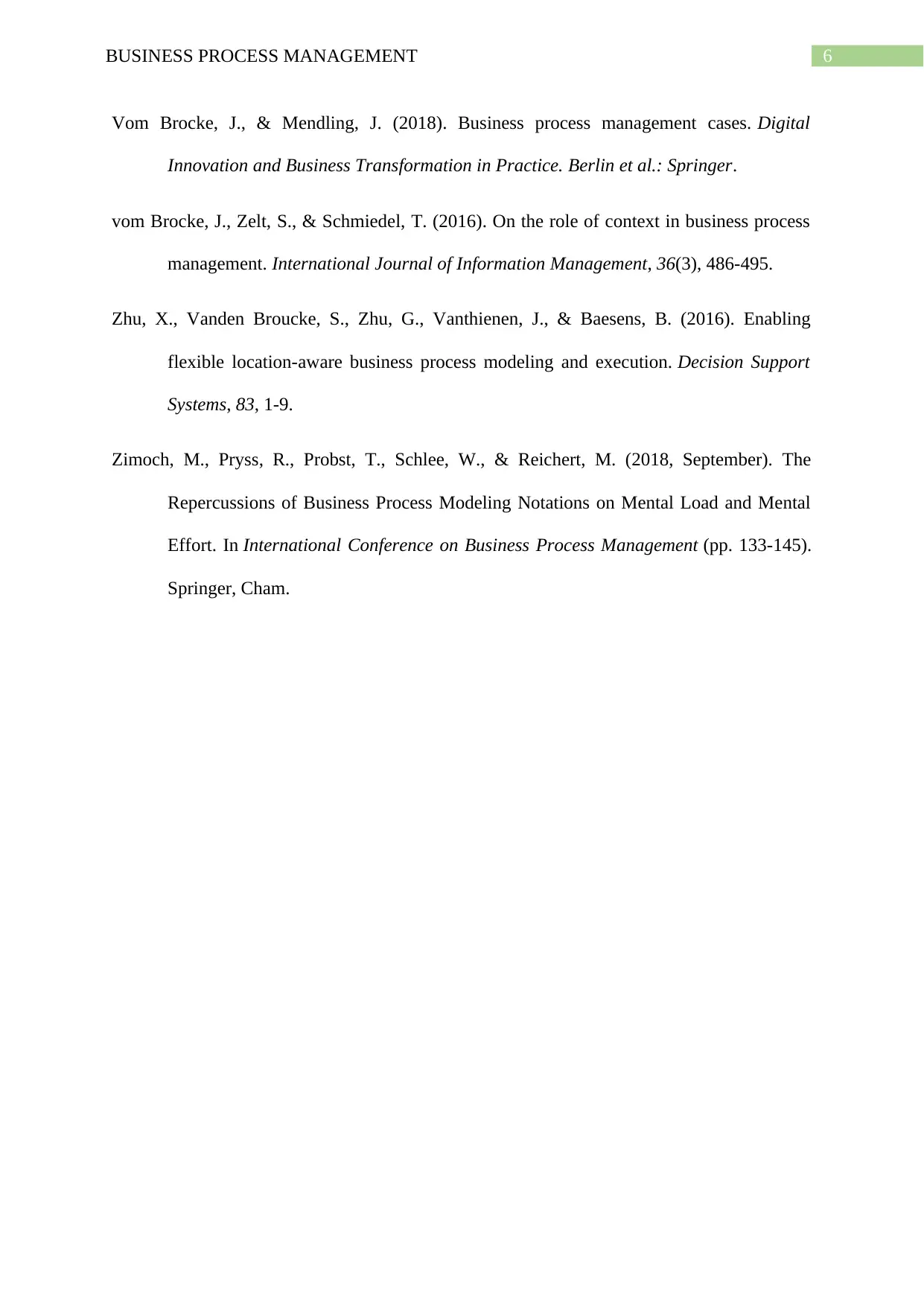
6BUSINESS PROCESS MANAGEMENT
Vom Brocke, J., & Mendling, J. (2018). Business process management cases. Digital
Innovation and Business Transformation in Practice. Berlin et al.: Springer.
vom Brocke, J., Zelt, S., & Schmiedel, T. (2016). On the role of context in business process
management. International Journal of Information Management, 36(3), 486-495.
Zhu, X., Vanden Broucke, S., Zhu, G., Vanthienen, J., & Baesens, B. (2016). Enabling
flexible location-aware business process modeling and execution. Decision Support
Systems, 83, 1-9.
Zimoch, M., Pryss, R., Probst, T., Schlee, W., & Reichert, M. (2018, September). The
Repercussions of Business Process Modeling Notations on Mental Load and Mental
Effort. In International Conference on Business Process Management (pp. 133-145).
Springer, Cham.
Vom Brocke, J., & Mendling, J. (2018). Business process management cases. Digital
Innovation and Business Transformation in Practice. Berlin et al.: Springer.
vom Brocke, J., Zelt, S., & Schmiedel, T. (2016). On the role of context in business process
management. International Journal of Information Management, 36(3), 486-495.
Zhu, X., Vanden Broucke, S., Zhu, G., Vanthienen, J., & Baesens, B. (2016). Enabling
flexible location-aware business process modeling and execution. Decision Support
Systems, 83, 1-9.
Zimoch, M., Pryss, R., Probst, T., Schlee, W., & Reichert, M. (2018, September). The
Repercussions of Business Process Modeling Notations on Mental Load and Mental
Effort. In International Conference on Business Process Management (pp. 133-145).
Springer, Cham.
1 out of 7
Related Documents
Your All-in-One AI-Powered Toolkit for Academic Success.
+13062052269
info@desklib.com
Available 24*7 on WhatsApp / Email
![[object Object]](/_next/static/media/star-bottom.7253800d.svg)
Unlock your academic potential
Copyright © 2020–2025 A2Z Services. All Rights Reserved. Developed and managed by ZUCOL.





